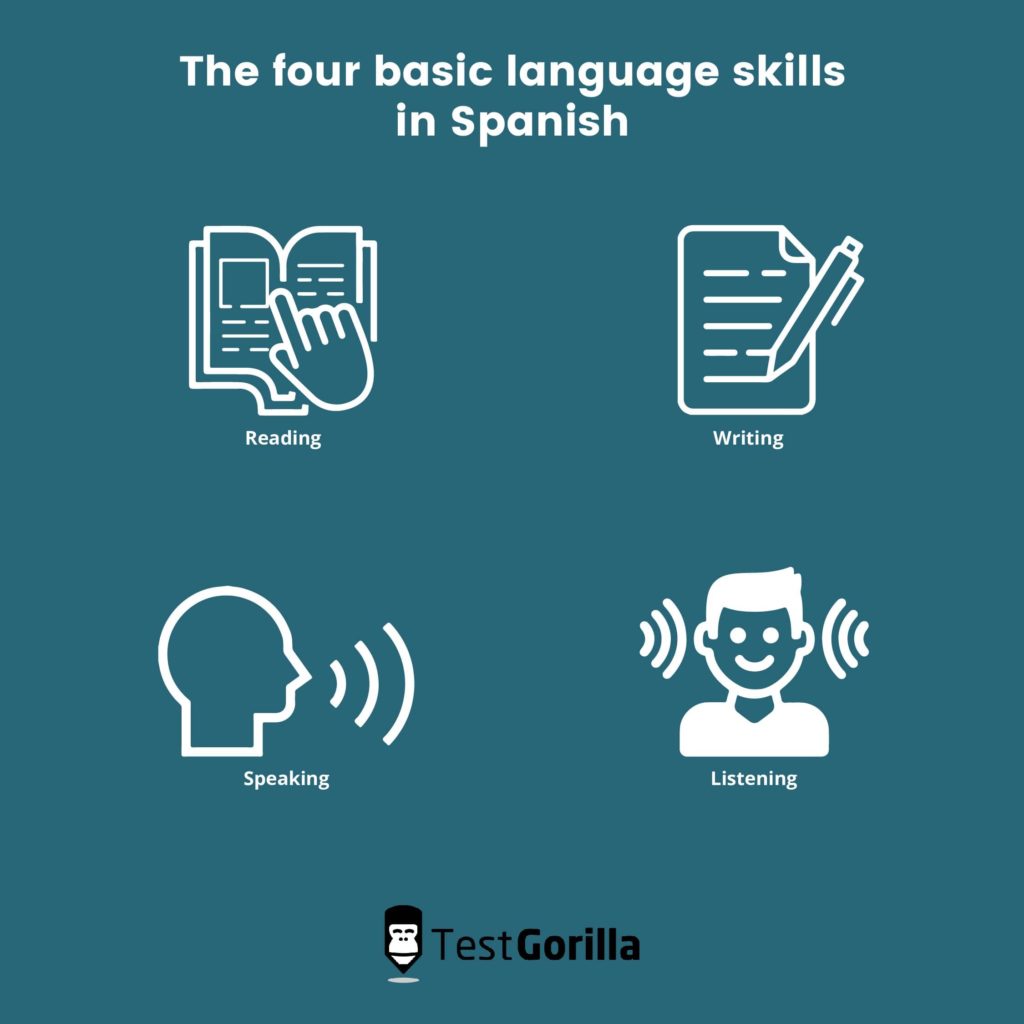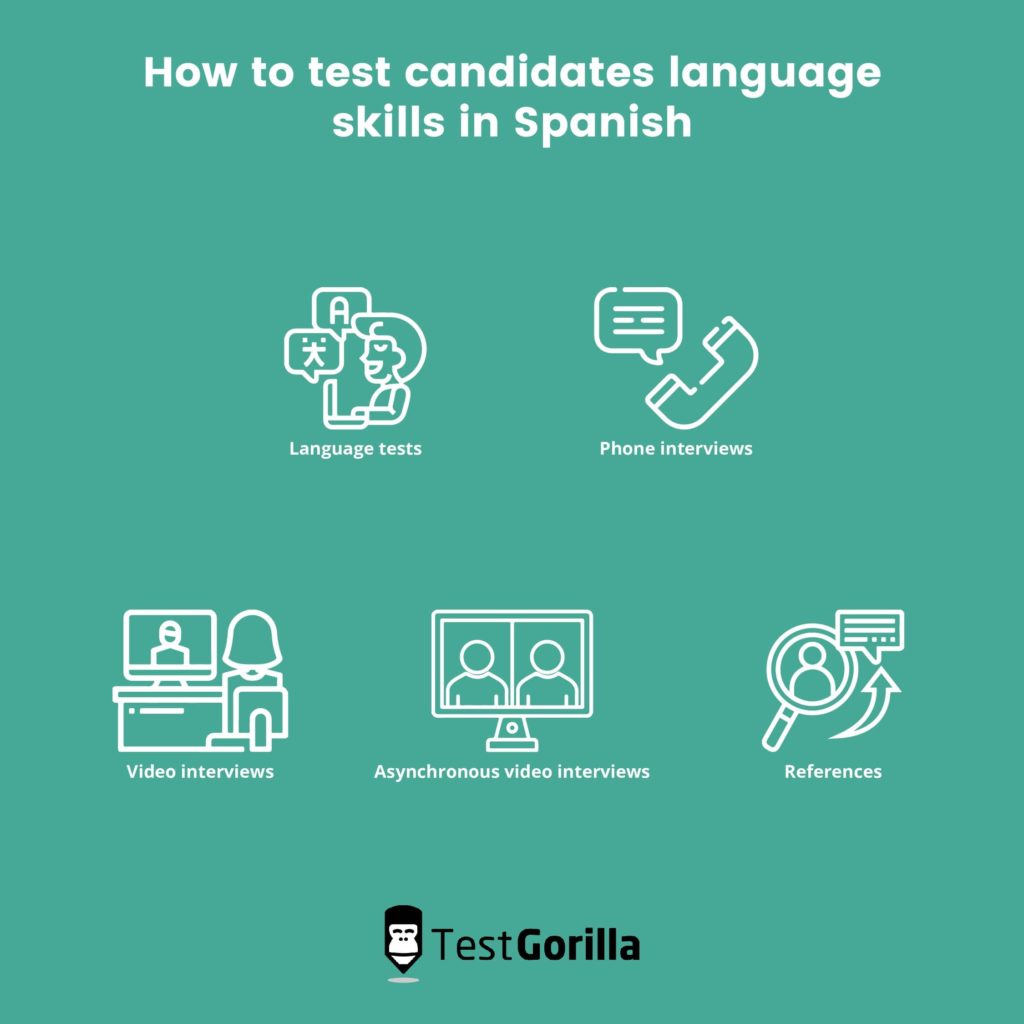This begs the question: How do you test for Spanish fluency to ensure that your candidate can work in Spanish and provide value to your organization?
How can you test simultaneously for other role-specific skills?
The short answer: a skills-testing platform that features Spanish tests for different levels of fluency – such as intermediate (B1), upper intermediate (B2) and proficient (C1).
You’ll find the long answer in this article, which will give you details about:
The four language skills that candidates need to master to be fluent in Spanish
The advantages of using language proficiency tests to assess Spanish fluency
Let’s jump right in.
Table of contents
Are you looking to hire a candidate who is fluent in Spanish?
Finding a candidate who is not only proficient in Spanish, but who can also help drive business results for your organization is a challenging task.
The four basic language skills in Spanish
To make sure you’ll hire someone who’s proficient in Spanish, you need to assess all four basic language skills during hiring: reading, writing, speaking, and listening.
Assessing all four skills is essential to hiring employees who are proficient in Spanish and can communicate effectively in the workplace.
By using a combination of language tests and interviews, you can get an in-depth picture of candidates’ language skills and make the right hiring decisions.
1. Reading
Reading is about how well your candidates can understand text written in Spanish. In most jobs, employees often need to work with written materials, such as emails, guides, memos, presentations, and more.
If your working language is Spanish, or if employees need to communicate with Spanish-speaking clients or partners, it’s important to assess their ability to read and understand content written in Spanish.
You can easily evaluate reading skills and overall proficiency with language tests.
2. Writing
Writing is about whether employees can express themselves in written form.
If your internal communication or communication with clients is in Spanish, you need to make sure employees can write clearly and concisely, without errors.
They might need to write emails, chat messages, presentations, articles, and other content in Spanish, and for this, they need to have excellent writing skills.
To test for writing skills, you can also use online language tests, which will help you assess candidates’ grammar, vocabulary, and spelling, as well as their capacity to construct clear sentences.
3. Speaking
Speaking refers to candidates’ ability to take part in conversations with clients, partners, coworkers, and managers in Spanish.
Day-to-day conversations might be in-person, on the phone, or in a video call, which is why candidates must be comfortable with the language and be able to express their ideas clearly and concisely.
Topics might vary in complexity, and, to communicate efficiently, employees also need to understand accents from different Spanish-speaking countries.
To evaluate applicants’ speaking skills, you have three options:
Use asynchronous video interviews: With TestGorilla, you can add custom video questions to skills tests, and ask candidates to record a short video to answer the question.
Conduct brief phone interviews in Spanish: After making an initial assessment of candidates’ language skills, cognitive abilities, and other role-specific skills, you can conduct brief phone interviews with shortlisted candidates,
Conduct final interviews in Spanish: Interviews are resource-intensive, which is why we recommend conducting them near the end of the recruitment process, and with your top candidates only.
If you’re looking to test speaking skills extensively, conducting the final interviews in Spanish would enable you to do that.
4. Listening
Last but not least, listening refers to employees’ ability to understand spoken Spanish, whether that’s in-person conversations or audio and video content.
If the working language of your organization is Spanish, employees need to understand colleagues, clients, and partners who speak with different accents, at different speeds, and on different topics.
To evaluate listening skills, you can use online language tests or conduct phone or video interviews in Spanish.
Alternatively, you can ask candidates to complete a task that requires them to listen to an audio recording and answer questions about it.
Language proficiency levels in Spanish: Which one do you need?
When testing candidates’ language skills, you’ll need to match the test with the proficiency level required for the job.
One of the most common frameworks for assessing language proficiency is the CEFR, or the Common European Framework of Reference for Languages. It comprises six levels:
A1 and A2: Basic user. Can perform basic tasks in Spanish, such as introducing themselves, ordering food, and asking for directions.
B1 and B2: Independent user. Can hold simple conversations, understand the main points of a text, and write clear and concise texts.
C1 and C2: Proficient user. Can communicate fluently and spontaneously, and also understand and write detailed, nuanced texts on complex topics.
Most jobs will require at least a B2 level. Highly technical roles might require a C1 or C2 level.
When administering a language proficiency test, you can choose the CEFR level that is best aligned with the requirements for the role.
With TestGorilla, you have the following options:
Let’s now look at the details of all six levels:
A1: Beginner
Candidates with an A1 level of Spanish are beginners.
They can use basic words and phrases and understand the simple sentences, but their capacity to communicate in the language is rudimentary. They can understand Spanish speakers who talk slowly and clearly.
A2: Elementary level
Candidates with an A2 level understand frequently used phrases and can hold simple conversations. They can share information about their jobs, family, and community, ask questions, and understand basic instructions.
For some blue-collar jobs in which employees aren’t speaking with clients, an A2 level might be sufficient.
B1: Lower intermediate
Candidates with a B1 level in Spanish can discuss simple topics orally or in written form, even though they’ll still make errors when communicating.
They can understand simple instructions in Spanish, ask for clarifications as needed, and perform day-to-day tasks for which they need to communicate with others. It might be necessary to speak slowly to them, and use simpler phrases, but overall they’ll be fairly independent.
For most blue-collar jobs, a B1 level will suffice; you can test for it using TestGorilla’s Spanish Intermediate (B1) test.
B2: Upper intermediate
Candidates with a B2 level of proficiency in Spanish can communicate with native speakers easily. They can write, speak, read, listen and talk about different topics.
Minor language mistakes might still be present, but candidates will be able to navigate most situations with ease. For many low- to mid-complexity jobs, a B2 level will be sufficient.
To check whether candidates meet the criteria for a B2 level, you can use TestGorilla’s Spanish Upper Intermediate (B2) test.
C1: Operational proficiency
Candidates with a C1 proficiency level are fully independent in their use of the language. They can understand and express themselves without difficulty, even in challenging situations. They can also write and present detailed, well-structured texts and reports.
For most jobs out there, a C1 level will be sufficient. You can test for it with our Spanish (Proficient/C1) test.
C2: Native-level proficiency
At C2, candidates are considered to have a native-level Spanish proficiency. They can navigate practically all situations, including the most complex ones, express themselves with spontaneity and ease. They might still have a non-native accent but will speak and write error-free.
For highly complex technical roles, a C2 level might be necessary.
How to test candidates’ language skills in Spanish
You can evaluate candidates’ proficiency level in Spanish in a few different ways.
Here are the most common methods:
Language proficiency tests
One of the best (and simplest) ways to test Spanish fluency is through language proficiency tests.
Pre-employment tests are reliable, objective, and bias-free, and enable you to assess language skills quickly and accurately.
TestGorilla’s Spanish fluency tests assess grammar, vocabulary, reading, listening, and comprehension of the language.
We have three Spanish fluency tests available:
Spanish (Intermediate/B1) test: For blue-collar or low-complexity jobs, you can use this test.
Spanish (Upper Intermediate/B2) test: For medium complexity jobs, you can administer a B2-level test.
Spanish (Proficient/C1) test: A C1 test is appropriate if you need candidates to be fluent and communicate with ease in practically any situation.
Phone interviews
Another way to assess fluency is by conducting brief phone interviews in which you speak with candidates in Spanish.
Phone interviews enable you to assess candidates’ listening and speaking skills. We advise you to conduct them with candidates who have already passed a language proficiency test.
This way, you’ll get a complete overview of their language skills and also not waste time with applicants who aren’t a good fit.
Video interviews
You can also conduct longer video interviews to assess language proficiency, or simply use Spanish in your final interviews.
Interviewing candidates takes a lot of time and resources, though, so we advise you to only do it at the end of the recruitment process, with your best candidates. Prior to that, you might wish to assess language proficiency with an online test, and also evaluate applicants’ role-specific skills.
Asynchronous video interviews
Asynchronous video interviews are a simpler alternative to video interviews, which also enables you to assess candidates’ speaking skills.
With TestGorilla, you can add custom video questions to skills tests and have candidates record a brief video response. Watch how your candidates express nuanced ideas to assess their speaking and presentation skills.
References
You can check with applicants’ previous employers, or even university tutors, whether they were fluent in Spanish. Do this at the end of the hiring process.
The advantages of using language proficiency tests to assess Spanish fluency
There are three major advantages to using TestGorilla’s Spanish fluency tests. They enable you to:
Assess candidates’ language skills reliably: You cannot rely on candidates’ claims on their resumes alone, but verifying Spanish proficiency is easy with a language proficiency test.
Hire bias-free: Tests are bias-free and provide you with an objective and reliable measurement of candidates’ skills. This will help you hire the best possible candidate out there.
Hire fast: Tests increase the speed with which you can assess and select candidates, thus reducing the time-to-hire. Filtering candidates will also be easier with this approach and it will save time for both you and the candidates.
In addition to that, you can combine language tests with other skills tests to get an in-depth understanding of candidates’ strengths, compare applications easily, and hire the best talent for the job.
With TestGorilla, you’ll find the recruitment process to be simpler, faster, and much more effective. Get started for free today and start making better hiring decisions, faster and bias-free.
Related posts
Hire the best candidates with TestGorilla
Create pre-employment assessments in minutes to screen candidates, save time, and hire the best talent.
Latest posts
The best advice in pre-employment testing, in your inbox.
No spam. Unsubscribe at any time.

Hire the best. No bias. No stress.
Our screening tests identify the best candidates and make your hiring decisions faster, easier, and bias-free.
Free resources
This checklist covers key features you should look for when choosing a skills testing platform
This resource will help you develop an onboarding checklist for new hires.
How to assess your candidates' attention to detail.
Learn how to get human resources certified through HRCI or SHRM.
Learn how you can improve the level of talent at your company.
Learn how CapitalT reduced hiring bias with online skills assessments.
Learn how to make the resume process more efficient and more effective.
Improve your hiring strategy with these 7 critical recruitment metrics.
Learn how Sukhi decreased time spent reviewing resumes by 83%!
Hire more efficiently with these hacks that 99% of recruiters aren't using.
Make a business case for diversity and inclusion initiatives with this data.






















